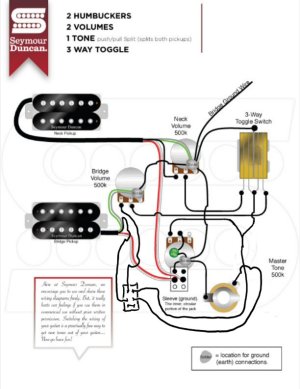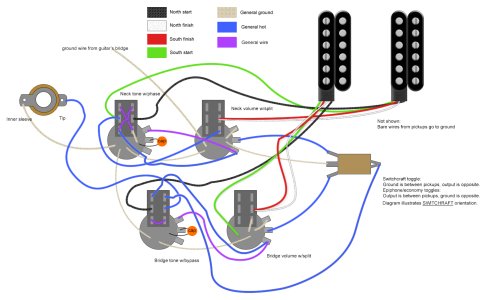amigarobbo said:
Ace Flibble said:
And no, there's no diagram for any of this! What you're asking for is very, very unusual.
It's standard Gibson wiring. :evil4:
There's nothing standard about individual splits, a phase switch and a bypass :laughing7:
And the 'tapping' on the Gibsons which you speak of is not tapping. It
is splitting, and you do get hum. They just happen to have less hum than a normal split because Gibson have vastly improved the internal shielding and grounding of all their pickups and PCB boards.
This is a common misunderstanding caused by Gibson's confusing marketing, which they were pretty much forced into because everybody gets tapping and splitting mixed up. I've literally talked to their UK PR team about this for a couple of hours while we sat in their London offices trying to work out how the hell to explain things to people properly.
Anyhoo, to answer the points you bring up:
Yes, it's better to just call it a bypass. The phrasing 'blower switch' is incredibly uncommon and very dated.
Your original post indicated you wanted to be able to choose what's going via the bypass. That is what causes the problmes. If you actually
don't want that and you
do just want the bridge pickup to go via bypass, that's very easy.
Wire the splits and phase switches as normal. Then, instead of sending the pickup signal from those switches to the volume pot, have them go to the bypass switch. From there you have one wire carrying on to the volume pot, and one to the jack. So the split/phasing comes before the bypass, and the pots and toggle come after the bypass.
Doing this does mean that if you have the toggle switch in the middle or neck position, and you activate the bypass, you'll get the bypassed bridge sound
on top of the neck pickup signal. You'll only get the plain bridge signal if you set the toggle switch to the bridge position.
To make it so the bypass also ignores the toggle switch, you will need to wire the toggle to the bypass. Where you'd normally wire through the pots, to the bypass and then on to the toggle, intead you'd wire to the pots, to the toggle, and then have the hot from the toggle return to the bypass.
So the bridge pickup goes to the split and then to the bypass. The 'off' part of the bypass goes to the volume and tone pots, and then to the toggle. The neck pickup goes to the split and the phase switch, and then the volume and tone pots, and then the toggle. The toggle's output then comes back to the bypass.
This will mean turning the bypass on will give you only the bridge output, and only the bridge split will be able to do anything; the volume and tone controls, and the whole neck pickup, won't give any signal.
The downside is you may indeed get some noticable bleedover. With a 4-pole switch you could negate the toggle switch more cleanly, but with the 3-pole you have with a push-pull, I have a feeling you'd find the volume and tone controls would have a slight effect on the pickups they're not meant to effect. This is very much an
in theory wiring scheme, 'cause I've never heard of anybody trying this specific combination of switches all at once, so you may find it works perfectly, or it might have such horrific bleedover that you basically have to treat all the volume and tone controls as master controls. I've installed all these elements in guitars before, but all of them
at once is something new.
I'll hack together a full schematic tomorrow, I've not quite got the time right at the moment.






